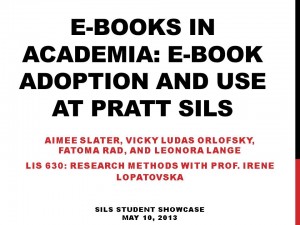Aimee Slater, Vicky Ludas Orlofsky, Fatoma Rad, and Leanora Lange
As part of a larger collaborative study on the use of e-books in academia conducted with Cristina Pattuelli’s Human Information Behavior course and partner libraries, students of Irene Lopatovska’s Research Methods course used three data collection methods to study how e-books are currently being used by SILS students.
SURVEY
Research Questions
- What characteristics of e-readers and e-books are most valued by users?
- What are the relationships between e-reader ownership and usage and the use of academic e-books?
- In what capacity is the Pratt SILS community primarily using e-readers?
- To what extent would SILS students be interested in borrowing e-books and/or e-readers from Pratt Institute Libraries?
Method
23-question survey sent to SILS students via SILS-Announce listserv in November 2012. Wording of survey workshopped in Research Methods class, created using SurveyMonkey. Some questions used skip logic to redirect users answering a specific way.
Results
- Total responses: 69 complete, usable responses from SILS students (including 12 from the Art History dual degree program). Age range: 21-23 (12), 24-28 (24), 29-34 (20), 35-50 (12), 50+ (1).
- The great majority, 86%, has used an e-reader. Most commonly owned and used device is the laptop (32 own and use, 12 use daily or a few times a week).
- Though more people own Kindles (27) than Nooks (10), usage of Nooks is higher than that of Kindles (Kindle: 15 use daily or a few times a week; Nook: 6 use daily or a few times a week).
- E-readers and e-books in general are more commonly used for leisure reading than academic.
- 64% have used e-books for academic purposes, and of those half (32%) have used them for 6 months to 2 years.
- Convenience is the most important feature for both e-readers (63%) and e-books (43%).
- E-readers are most commonly used in transit (54%) or at home (48%).
- 20 (29% of total, 62% of those who answered these questions) would be very or somewhat likely to use e-books if available through Pratt Institute Libraries, but are more divided on whether they would borrow an e-reader (yes: 17; no: 18; no response: 7).
FOCUS GROUPS
Research Questions
- How are Pratt SILS students using e-readers in their academic work?
- How are Pratt SILS students using e-books in their academic work?
- What are Pratt SILS students’ general sentiments towards using e-resources in their academic work?
- Would Pratt SILS students benefit from having more access to e-books through their library?
Method
Two focus groups were conducted in November 2012, three people in the first and six in the second. Prior to the session, each participant filled out a demographic survey. Two researchers led each group, one asked questions while the other took notes and recorded audio using a smart pen. Each researcher coded the data from the recordings, then analyzed the results with feedback from the research team. Although there were not enough participants to form profiles, we did identify some key trends.
Results
- Some students are using e-readers for strictly academic purposes to obtain assigned articles or course readings.
- Most participants usually send the articles in PDF forms to their e-reader.
- However, students noted that taking notes on the e-reader while reading a PDF is difficult and often requires another app or using a pen and paper to take notes.
- These issues translated into the fact that the technology to accommodate academic users may not be all there yet
- Many students opted to download the PDF and print it, especially when it came to the length of the piece.
- Some students found that they preferred to read a hard copy when it was a longer piece of academic literature versus a shorter piece.
- Participants’ definitions of “e-book” ranged from “anything in e-formatting” to the idea that an e-book had to be something with an ISBN number if the e-book was in print form.
- There was some interest in accessing e-books from Pratt Institute Libraries. Participants noted that it would make sense to have e-books available in the library if Pratt had more online courses since the two seem to go hand in hand.
INTERVIEWS
Research Questions
- When doing research, under what circumstances do students prefer print to electronic resources?
- How do experience and comfort with technology influence the use of e-books for academic purposes?
- To what extent is the Pratt student population e-book ready?
Method
Semi-structured interviews with 10 SILS students, qualitative analysis of interview data
Results
- Widespread use of e-books and e-readers and support for having them at Pratt libraries
- Further detail about reasons to use e-books and how they are being used
- Convenience:
- “…the ability to have something at a moment’s notice[.]”
- “I guess a lot has to do with convenience, just being able to do it [use e-books] from anywhere from my computer. I feel that’s the major reason and that there is stuff that you wouldn’t be able to find at the library […] that you would have access to.”
- Access:
- Sources mentioned: Amazon.com, NYPL, iTunes, HathiTrust, and Pratt LMS
- Circumnavigation of access barriers common
- Convenience:
- Print preferred over e-resources for the ability to search for keywords and highlighting
- Using grounded theory approach, found that the definition of an e-book is variable:
- E-books made for e-readers or e-book platforms vs. other e-resources
Acknowledgements
This study was conducted with Pratt Institute School of Information and Library Studies students Davis Erin Anderson, Caitlin Bronner, Emily Decker, Houda El Mimouni, Amy Laughlin, Debbie Liu, Julia Marden, and Teresa Silva under the direction of Dr. Irene Lopatovska.


1 Comment
1 Pingback